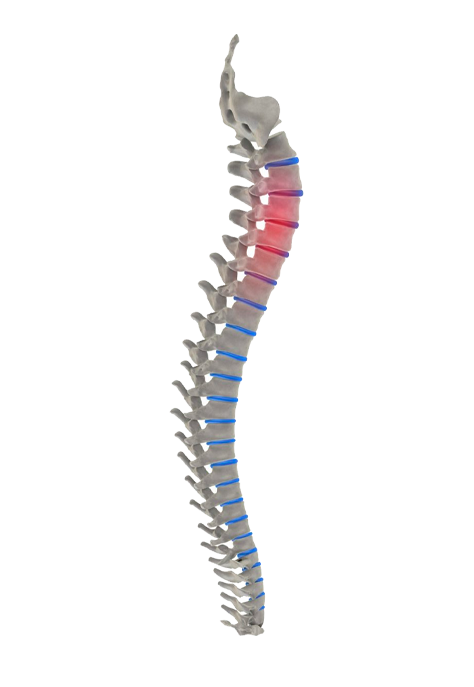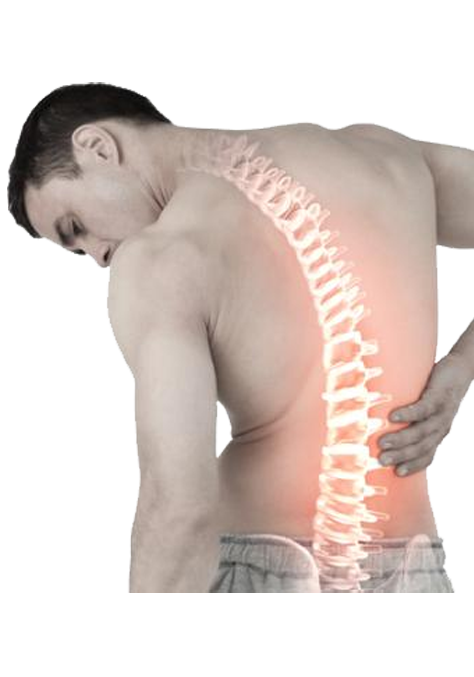Spine Surgery
Spine Surgery
If you’ve struggled with back pain for any length of time, you may be wondering if spine surgery is your only treatment option. Sometimes, surgery is the only treatment. However, there’s good news. The vast majority of back problems can be remedied with non-surgical treatments—often referred to as non-surgical or conservative therapies.
Aging, improper body mechanics, trauma and structural abnormalities can injure your spine, leading to back pain and other symptoms such as leg pain and/or numbness or even leg weakness. Chronic back pain is a condition that generally requires a team of health professionals to diagnose and treat. Before resigning yourself to surgery, consider getting opinions from several spine specialists. This investment of time and information-gathering will help you make an informed treatment decision that will best support your lifestyle and desired level of physical activity.
Common Spine Problem
Slipped Disk
A cushion called a disk sits between each of your vertebrae, so they don't scrape against each other. As you age, the disks start to dry out. If you put too much stress on your back, a disk may tear or break. Doctors call this a herniated disk. You may not notice. But your arms or legs might hurt, or they could feel numb or tingly. Usually, exercise and painkillers help. If not, you may need an operation.
Cervical Spondylosis
It's the result of the gradual breakdown in your neck as you get older. You could get a slipped disk there, or the vertebrae may sprout extra bone called spurs to try to boost strength. The ligaments that connect the vertebrae can get stiff and tight. Regardless of the cause, your neck may hurt or be harder to move. If disks or vertebrae squeeze nerves and nerve roots a lot, you could have permanent damage.
Osteoarthritis
Your vertebrae have slippery tissue on each end that helps your back flex without friction. If that cartilage gets rough or wears down, the vertebrae start to rub against each other, and it makes your back painful or stiff. Women are more prone than men to get osteoarthritis in their backs, and it tends to get worse over time. Your doctor can't reverse it. But painkillers, therapy, and exercise help ease the symptoms.
Spinal Stenosis
Your spine has spaces in it for your spinal cord and the nerves that branch out from it. When those spaces shrink, bones can press against nerves. You might not even notice it, but any time nerves are messed with, you could have pain, tingling, or numbness, or your muscles might seem weak. Osteoarthritis is the most common cause of spinal stenosis. When it's severe, a surgeon goes in and makes more room for the nerves.
Sciatica
If pain shoots down from your lower back, through your bottom, and into your leg, the culprit may be your sciatic nerve. A herniated disk, bone spur, or some other spine problem can put pressure on it. Doctors call this sciatica. It usually affects only one side of your body. Hot packs, cold packs, stretching, and painkillers can help you feel better, but you may need a doctor to fix the cause.
Tumor
Sometimes, cancer spreads from the spot where it starts to form a new growth in your spine. Lung, breast, prostate, and bone cancers are more likely to go there. A few non-cancer conditions can create a spine tumor, too. Your back might hurt, with the pain spreading through your body. Your arms or legs might be numb or weak. Part of your body could even be paralyzed. Your doctor may recommend surgery, radiation, or chemo.
Scoliosis
Scoliosis is one of the conditions that can twist your spine out of shape. The most common type affects children during their growth spurt before puberty, bending the spine sideways. If your child has scoliosis, their shoulders might be uneven, or one shoulder blade might stick out more than the other. Nobody knows what causes this. Scoliosis can get worse and cause problems, but a brace may help prevent that and the need for surgery to correct it.
Kyphosis
This condition bends your spine forward. It usually happens when your vertebrae crack or mash down. Older women get it most often, but it can also affect children whose spines develop wrong. It can cause pain and other problems, and in severe cases, it bends your whole body out of shape. Depending on how curved your spine is, treatment might include painkillers, exercise, or surgery.
Ankylosing Spondylitis
This type of arthritis typically starts off making your low back and hips stiff and sore, especially in the morning. Over time, it can spread up your spine and to other joints and organs. Vertebrae and bones in your rib cage could fuse, leaving you hunched over. Young men get it more often than women, and it may run in families. Early treatment with exercise and medication helps slow the progress.
Spinal Cord
An injury most often comes from an accident (like a fall, car crash, or sports mishap) or from a gunshot. In most cases, the spinal cord gets bruised, or part of its blood supply is cut off. That may keep your brain from controlling part of your body, so it can be very serious. The higher on your spine, the more of your body is affected. Your chance of getting better depends on how bad the injury is.
Broken Neck or Back
Accidents and injuries can also break bones. When that happens to one of the top seven vertebrae, just below your skull, it’s called a broken neck; farther down is a broken back. Bone loss because of age can make your back weak, too, and you might get a break that happens slowly over time. In that case, a back brace or surgery may help. Broken vertebrae could also hurt your spinal cord.
Spondylolisthesis
Vertebrae might slide sideways, so that they don't line up with the ones above and below them. Spondylolisthesis is a main cause of lower back pain. It happens as your body ages, but it also can affect young people who do sports that stress the lower back, like football, gymnastics, and weightlifting. Rest should help. If the pain keeps up, you may need surgery.

Cauda Equina Syndrome
The nerves that branch out from your spine in your lower back help your brain control your legs and the organs in your pelvis. A herniated disk, fracture, or other condition could put pressure on this group of nerves, called the cauda equina, causing this rare but dangerous ailment. You need surgery right away to restore any loss of feeling, movement, or control of your bladder and bowels.
Syringomyelia
In rare cases, a little fluid-filled sac called a cyst can form in your spinal cord. It could happen when brain tissue pushes down from your skull into your spinal cord, or from an injury or tumor. Syringomyelia may not give you any problems. But if the cyst keeps growing, it can injure your spinal cord, and you could end up needing surgery.
Different types of back surgery include:
Diskectomy: This involves removal of the herniated portion of a disk to relieve irritation and inflammation of a nerve. Diskectomy typically involves full or partial removal of the back portion of a vertebra (lamina) to access the ruptured disk.
Laminectomy: This procedure involves the removal of the bone overlying the spinal canal. It enlarges the spinal canal and is performed to relieve nerve pressure caused by spinal stenosis.
Fusion: Spinal fusion permanently connects two or more bones in your spine. It can relieve pain by adding stability to a spinal fracture. It is occasionally used to eliminate painful motion between vertebrae that can result from a degenerated or injured disk.
Artificial Disks: Implanted artificial disks are a treatment alternative to spinal fusion for painful movement between two vertebrae due to a degenerated or injured disk. But these relatively new devices aren't an option for most people.

Dr. Abhishek Bansal
 +91-9142424264
+91-9142424264 Book an Appointment
Book an Appointment